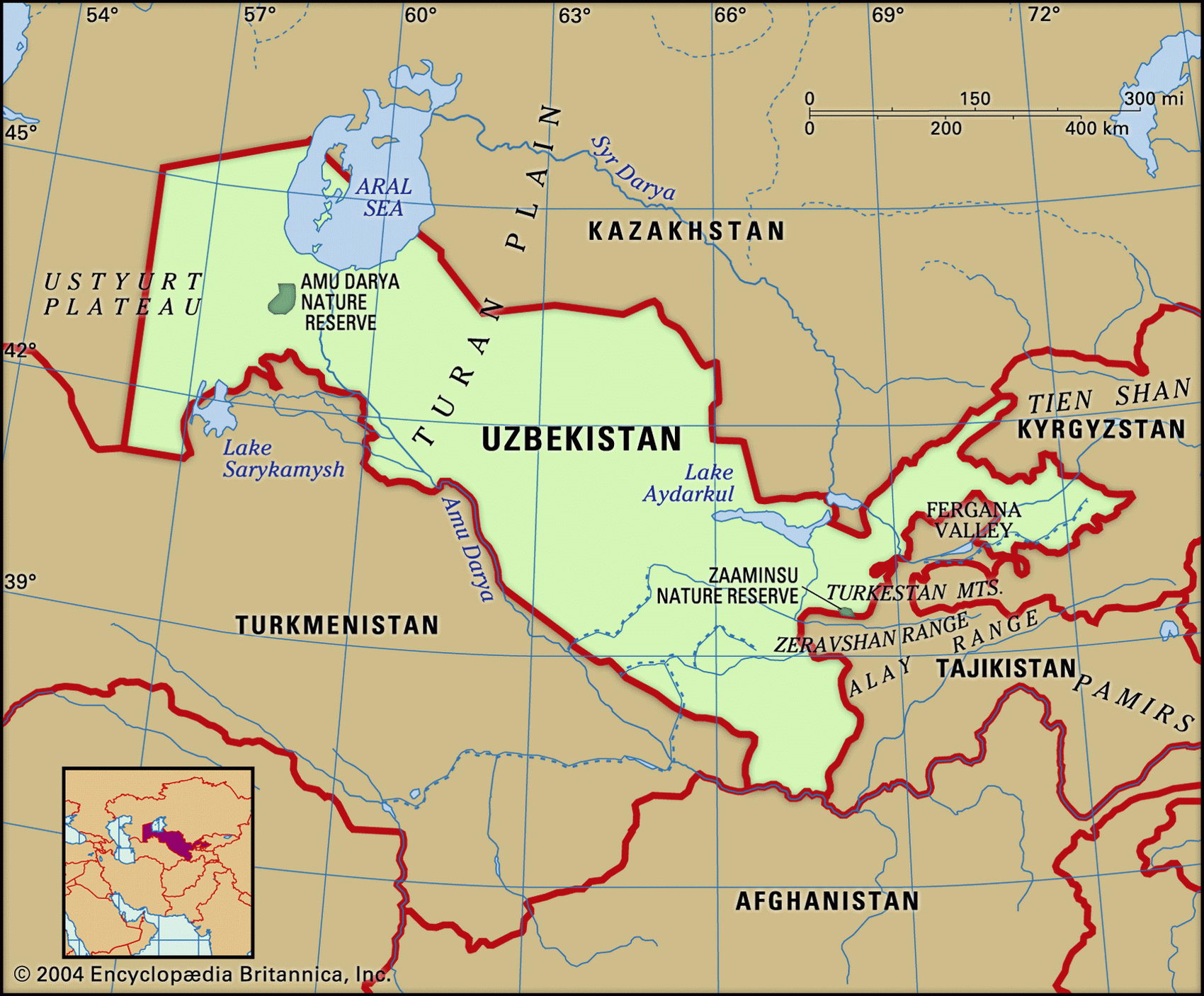Map of Uzbekistan and geographical facts
Uzbekistan on the world map. Map of Uzbekistan
Map of Uzbekistan with cities. Where Uzbekistan is on the world map. The main geographical facts about Uzbekistan - population, country area, capital, official language, religions, industry and culture.

Uzbekistan Fact File
Official name Republic of Uzbekistan
Form of government Republic with single legislative body (Supreme Assembly)
Capital Toshkent (Tashkent)
Area 447,400 sq km (1 72,741 sq miles)
Time zone GMT + 6 hours
Population 25,564,000
Projected population 2015 30,554,000
Population density 57.1 per sq km (148 per sq mile)
Life expectancy 63.9
Infant mortality (per 1,000) 71.1
Official language Uzbek
Other languages Russian, Tajik
Literacy rate 99 %
Religions Muslim 88% (mostly Sunnis), Eastern Orthodox 9 %, other 3 %
Ethnic groups Uzbek 71.4 %, Russian 8.3%, Tajik 4.7%, Kazak 4.1 %, Tatar 2.4%, other 9.1 %
Currency Som
Economy Agriculture 43%, services 35%, industry 22 %
GNP per capita US$2,500
Climate Mainly arid, with cold winters and long, hot summers
Highest point Adelunga Toghi 4,301 m (14,111 ft) Map reference Pages 222-23
Uzbekistan stretches from the shrinking Aral Sea to the heights of the western Pamirs. Its main frontiers are with Kazakhstan to the north and Turkmenistan to the south. The Uzbek people are of Turkic origin and seem to have taken their name from the Mongol Oz Beg Khan (ad 1313-40), who may also have converted them to Islam. In the fifteenth century they moved south into their present land. The Muslim cities of Samarqand and Bukhoro are in Uzbekistan, Bukhoro being a major religious center. Muslims unable to visit Mecca can become hajis by visiting Bukhoro seven times
The city of Kabol in Afghanistan, devastated by years of warfare (left page bottom). The Tila Kara Marasa, in Registan Square, Samarqand, Uzbekistan, built in the seventeenth century (above).
instead. In the former USSR the territory was the Uzbek Soviet Socialist Republic, and Uzbek leaders suffered much during Stalin's purges. In 1991 Uzbekistan became independent and is today ruled by the old communist elite as a de facto one-party state. The most populous of the Central Asian republics, Uzbekistan also has the greatest variety of ethnic groups. This is often a source of conflict. The Turkish-speaking Uzbeks clash with the Farsi-speaking Tajiks, and the Meskhetian Turks (deported from Georgia to Central Asia by Stalin) clash with the Uzbeks in the Fergana Valley. In 1999/2000, the Islamic Movement tried in vain to erect an Islamic Caliphate there.
The middle region of Uzbekistan consists of the desert plains of the Kyzyl Kum (Peski Kyzylkum). While some of this area supports herders with cattle and sheep, today it is more important for its oil and gas reserves. To the west is the river delta formed where the Syrdar'ya (Oxus) enters the Aral Sea, while the Ustyurt Plateau lies in the extreme northwest. East of the Kyzyl Kum, beyond the capital of Toshkent and the Chatkal Mountains, is a spur jutting into Kyrgyzstan. This contains a large part of the fertile Fergana Basin. Uzbekistan is the world's fourth-largest cotton producer, and the Fergana Valley bears the environmental scars of the fertilizers and pesticides which helped to bring this about.
Although it grows large quantities of cotton, Uzbekistan is unable to produce enough grain for its own needs, importing it from Russia, Kazakhstan, and the USA. A rethinking of the Soviet-style economy has yet to take place.
As well as one of the world's largest goldmines, at Murantau, Uzbekistan has large deposits of natural gas, petroleum, coal, and uranium. Gas is currently used domestically, but it could become a major export. After 1991 the government tried to strengthen the economy with subsidies and tight price controls. Inflation rose to 1,500 percent at one point and in 1995 food rationing had to be introduced. At present, efforts are being made to tighten monetary policies, expand privatization, and to reduce the state's role in the economy, but so far there have been few serious structural changes.